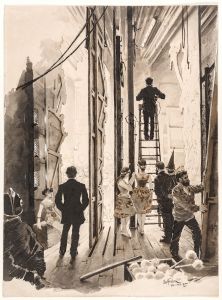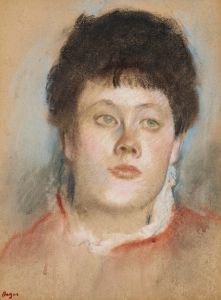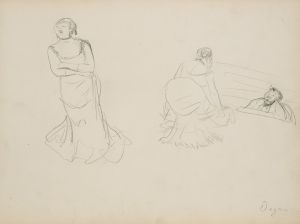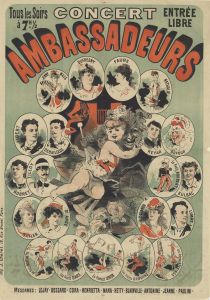
Mademoiselle Bécat på Ambassadeurs
A hand-painted replica of Edgar Degas’s masterpiece Mademoiselle Bécat på Ambassadeurs, meticulously crafted by professional artists to capture the true essence of the original. Each piece is created with museum-quality canvas and rare mineral pigments, carefully painted by experienced artists with delicate brushstrokes and rich, layered colors to perfectly recreate the texture of the original artwork. Unlike machine-printed reproductions, this hand-painted version brings the painting to life, infused with the artist’s emotions and skill in every stroke. Whether for personal collection or home decoration, it instantly elevates the artistic atmosphere of any space.
Edgar Degas, a prominent French artist known for his contributions to Impressionism, created a wide array of works that captured the essence of modern life in the late 19th century. Among his diverse subjects, Degas frequently depicted scenes from the world of entertainment, including ballet, opera, and café-concerts. One of his works, "Mademoiselle Bécat at the Ambassadeurs," reflects his interest in the vibrant nightlife of Paris.
"Mademoiselle Bécat at the Ambassadeurs" is a pastel drawing that showcases Degas's skill in capturing the dynamic atmosphere of a performance venue. The Ambassadeurs was a well-known café-concert in Paris, a popular venue where patrons could enjoy music, dance, and other forms of entertainment. These venues were an integral part of Parisian social life during the late 19th century, offering a space where different classes could mingle and enjoy performances.
Degas's work often focused on the performers themselves, capturing their expressions, movements, and the ambiance of the setting. In this particular piece, Degas portrays Mademoiselle Bécat, a performer at the Ambassadeurs. The use of pastel allows Degas to create a sense of immediacy and vibrancy, with rich colors and dynamic lines that convey the energy of the performance. The medium also enables Degas to experiment with light and shadow, adding depth and texture to the scene.
The composition of "Mademoiselle Bécat at the Ambassadeurs" is typical of Degas's style, with an emphasis on capturing a moment in time. His approach often involved unusual angles and perspectives, which can be seen in this work as he focuses on the performer, perhaps from the viewpoint of an audience member. This perspective invites the viewer into the scene, creating a sense of participation in the lively atmosphere of the café-concert.
Degas's interest in such subjects was part of a broader trend among Impressionist artists to depict contemporary life and leisure activities. Unlike some of his contemporaries, Degas was less concerned with the effects of natural light and more focused on the human figure and the nuances of movement and expression. His works often reveal a keen observation of human behavior and social interaction, reflecting the complexities of modern urban life.
While "Mademoiselle Bécat at the Ambassadeurs" is not as widely known as some of Degas's other works, it nonetheless exemplifies his mastery of pastel and his ability to capture the spirit of Parisian entertainment culture. The piece is a testament to Degas's enduring interest in the world of performance and his skill in portraying the vibrancy of the era.
Overall, Edgar Degas's work, including "Mademoiselle Bécat at the Ambassadeurs," offers valuable insights into the cultural life of 19th-century Paris. His art continues to be celebrated for its technical brilliance and its ability to convey the energy and complexity of the world he observed.


















